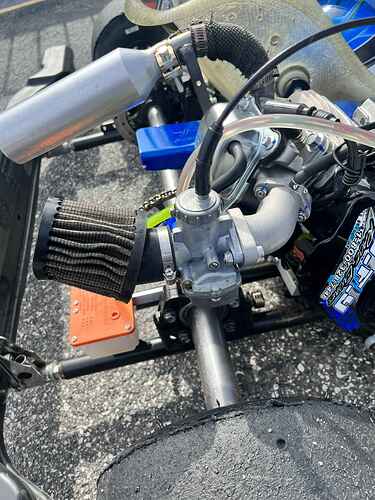This is going to be a long story, but the starting problems have been an issue since the engine was released. We have felt like we’ve been caught in the middle of this program since we started it at the end of 2015.
I’ll first address the difference between Tillotson MFG, Ireland, USA, and EC.
Tillotson was bought by Borg Warner in the late '60s and sold in the early to mid-80s. I believe Borg Warner built the factory in Ireland, which became the location where Tillotson carburetors were manufactured. It’s an Irish company owned by Americans.
Tillotson-USA was EC. EC was advertised as EC Tillotson USA in all the kart magazines or online publications for decades. EC became the primary importer of carburetors for kart racing around the time Borg Warner sold the company. EC designed and developed many of its carburetors. Part of the problem is so many people believe EC was Tillotson. That’s not the case. However, EC developed the carburetors, wrote the technical articles, blueprinted the carburetors, and built the reputation for decades. We even helped develop the Tillotson 196R, 212R, and 225RS engines, with some exceptions regarding the carburetor and exhaust systems.
First, the carburetors. Tillotson started with an HW diaphragm carburetor. There isn’t a greater authority with Tillotson carburetors on 4-cycle engines than we are, having designed many of the ones sold by Tillotson. We told them you would have a problem getting the diaphragm carburetor to idle on any 4-cycle engine, and it’s not something you want to use for a spec class. They tried to reassure us they could get it to work.
To get the carburetor to idle, you can try setting a high pop-off pressure or leaning out the low side circuit, but the engine becomes difficult to start, and it isn’t going to perform very well. Tillotson had both issues. The engine wouldn’t start, so they came up with a starting procedure they posted on YouTube that included removing the air filter and choking the engine by hand to get it to start, but it would still take many pulls to start. The other problem is a very narrow tuning window and the sensitivity of the high and low-speed needles.
We were able to fix the starting issues and improve the carburetor, but Tillotson decided to switch to their TCT, which I don’t believe made it state-side but was covered in an article with Vroom or Tkart. Then, they switched to a knock-off “VM22” from one of their other distributors before rebranding a version of the FM22.
We had already worked on these knock-offs, which are not knock-offs of the Mikunii VM22 but more similar to a PZ26, like what comes on the World Formula.
We made our own casting and brand with the Wildcat WC22. We fixed the starting and tuning issues.
Tillotson has refused to believe they have a carburetor problem. They have reworked the ignition coil and gone through several different spark plugs, trying to blame the problem on something else. We’re glad this post made the point that switching to(of all the carburetors) a Briggs carburetor. Insult to injury.
The other part that we disagreed on is the exhaust. The exhaust is too short and too restrictive. It contributes to some of the starting issues and, we believe, the main problem with the engine’s durability. The header keeps a lot of back pressure and heat in the cylinder head. The carburetor also runs too rich, and any unburnt fuel is caught and burned in the exhaust. We have any one racer send us pictures of an exhaust that has blown apart.
Finally, after years of battling this issue, RLV has created a new exhaust more like the traditional ones used on the Briggs or the oval racing Clones. We haven’t tested one yet, but we believe this should help.
That said, we don’t support the Tillotson 225RS class to protest how the program has been handled. Outside the engine issues, we have had issues because the distribution of this engine doesn’t come through us. Had the engine come through us, we could have forced the right changes, and this wouldn’t have been an issue. However, the other distributors lacked the knowledge and experience and decided to sell the engines anyway. Those companies are ones you may never have heard of or have never been associated with 4-cycle karting or Tillotson carburetors. For them, it’s of no consequence because they’re not the ones mentioned in this post, but we are.
That is why we have been fairly silent for the last four years on this program.
So, how do we fix the issue?
Many of our customers have thrown the rule book away or created their own and started using one of our carburetors and exhausts. While they are not rev-limited and not a spec engine, we have even sold them our 228cc version or components to build 236cc versions.
We will not blueprint FM22 carburetors. We cannot support that carburetor because it’s not something we designed, and it’s too accessible to other distributors; we will not support their mistakes so they can sell engines, especially when the factory should have never sold the engine with a poorly functioning carburetor.
Our Wildcat WC22 is based on the same carburetor, so it’s dimensionally the same as the FM22. Our carb works, and most importantly, you have someone that can support it. We have a better version of the curved intake or, if you prefer, our short intake manifold. We recommend using our ETC5011 header with the 4106 muffler.
If you think it’s wrong for us to sell you parts for your engine, we agree. Tillotson should have had the engine right from the start.
